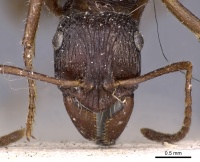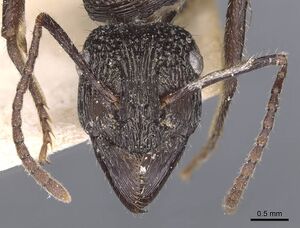Ectatomma muticum
| Ectatomma muticum | |
|---|---|

| |
| Scientific classification | |
| Kingdom: | Animalia |
| Phylum: | Arthropoda |
| Class: | Insecta |
| Order: | Hymenoptera |
| Family: | Formicidae |
| Subfamily: | Ectatomminae |
| Tribe: | Ectatommini |
| Genus: | Ectatomma |
| Species: | E. muticum |
| Binomial name | |
| Ectatomma muticum Mayr, 1870 | |
| Synonyms | |
| |
This species attended extrafloral nectaries of the plant Turnera subulata in northeastern Brazil (12°16′24″S 38°57′20″W / 12.27333°S 38.95556°W) Caatinga vegetation. Ectatomma muticum was classified as a subordinate species and was infrequently observed. (Passos and Leal 2019)
Identification
Distribution
Latitudinal Distribution Pattern
Latitudinal Range: 5.133333° to -19.653°.
| North Temperate |
North Subtropical |
Tropical | South Subtropical |
South Temperate |
- Source: AntMaps
Distribution based on Regional Taxon Lists
Neotropical Region: Brazil (type locality), Mexico.
Distribution based on AntMaps
Distribution based on AntWeb specimens
Check data from AntWeb
Countries Occupied
| Number of countries occupied by this species based on AntWiki Regional Taxon Lists. In general, fewer countries occupied indicates a narrower range, while more countries indicates a more widespread species. |

|
Estimated Abundance
| Relative abundance based on number of AntMaps records per species (this species within the purple bar). Fewer records (to the left) indicates a less abundant/encountered species while more records (to the right) indicates more abundant/encountered species. |

|
Biology
Castes
Worker
Images from AntWeb
   
| |
| Syntype of Ectatomma muticum lobulifera. Worker. Specimen code casent0907181. Photographer Will Ericson, uploaded by California Academy of Sciences. | Owned by MHNG, Geneva, Switzerland. |
Nomenclature
The following information is derived from Barry Bolton's Online Catalogue of the Ants of the World.
- muticum. Ectatomma muticum Mayr, 1870b: 962 (w.) BRAZIL (Ceará).
- Type-material: syntype workers.
- Type-locality: Brazil: Ceará (no collector’s name).
- Type-depository: NHMW.
- Almeida, 1986: 26 (m.); Almeida, 1987: 176 (q.).
- Combination in Ectatomma (Ectatomma): Mayr, 1887: 539.
- Junior synonym of edentatum: Gallardo, 1918b: 36.
- Subspecies of edentatum: Forel, 1912c: 31; Borgmeier, 1923: 57.
- Status as species: Mayr, 1887: 541; Dalla Torre, 1893: 25; Forel, 1895b: 112; Emery, 1911d: 43; Brown, 1958g: 208, 298; Kempf, 1972a: 105; Kugler, C. & Brown, 1982: 6 (in key); Almeida: 1986: 26; Almeida: 1987: 176; Brandão, 1991: 341; Bolton, 1995b: 187; Feitosa, 2015c: 97; Camacho, Franco, Branstetter, et al. 2022: 10.
- Senior synonym of lobulifera: Brown, 1958g: 208; Kempf, 1972a: 105; Almeida, 1986: 26; Bolton, 1995b: 187.
- Distribution: Brazil.
- lobulifera. Ectatomma muticum var. lobulifera Forel, 1909a: 254 (w.) BRAZIL (Ceará).
- Type-material: syntype workers (number not stated).
- Type-locality: Brazil: Ceará (Diaz da Rocha).
- Type-depositories: MHNG, NHMB.
- Subspecies of muticum: Forel, 1911c: 286; Emery, 1911d: 43.
- Subspecies of edentatum: Forel, 1912c: 31; Borgmeier, 1923: 57.
- Junior synonym of muticum: Brown, 1958g: 208; Kempf, 1972a: 105; Almeida, 1986: 26; Bolton, 1995b: 187.
Description
Karyotype
- n = 20, karyotype = 16M+4A; 32M+ 8A (Brazil) (Barros et al., 2008; Mariano et al., 2015).
References
- Albuquerque, E., Prado, L., Andrade-Silva, J., Siqueira, E., Sampaio, K., Alves, D., Brandão, C., Andrade, P., Feitosa, R., Koch, E., Delabie, J., Fernandes, I., Baccaro, F., Souza, J., Almeida, R., Silva, R. 2021. Ants of the State of Pará, Brazil: a historical and comprehensive dataset of a key biodiversity hotspot in the Amazon Basin. Zootaxa 5001, 1–83 (doi:10.11646/zootaxa.5001.1.1).
- Almeida Filho, A. J. de. 1986. Descriça~o de quatro machos do gênero Ectatomma Smith, 1858 (Hymenoptera, Formicidae, Ponerinae). Quid (Teresina) 6: 24-38 (page 26, male described)
- Almeida Filho, A. J. de. 1987a. Descriça~o de seis fêmeas do gênero Ectatomma Smith, 1858 (Hymenoptera, Formicidae, Ponerinae). An. Soc. Nordestina Zool. 1: 175-183 (page 176, queen described)
- Brown, W. L., Jr. 1958g. Contributions toward a reclassification of the Formicidae. II. Tribe Ectatommini (Hymenoptera). Bulletin of the Museum of Comparative Zoology 118: 173-362 (page 208, Revived status as species, and senior synonym of lobulifera)
- Camargo, K.S. de. 2011. Composicao e diversidade de "Poneromorfas" (Hymenoptera, Formicidae) em duas fitofisionomias de cerrado e padroes de distribuicao de "Poneromorfas", Pseudomyrmecinae e Cephalotini (Myrmicinae) para o Brasil. Thesis, Universidade de Brasilia.
- da Silva, C.H.F., Arnan, X., Andersen, A.N., Leal, I.R. 2019. Extrafloral nectar as a driver of ant community spatial structure along disturbance and rainfall gradients in Brazilian dry forest. Journal of Tropical Ecology 35, 280–287 (doi:10.1017/s0266467419000245).
- Forel, A. 1912d. Formicides néotropiques. Part I. Ann. Soc. Entomol. Belg. 56: 28-49 (page 31, Race of edentatum)
- Mariano, C.S.F., Santos, I.S., Silva, J.G., Costa, M.A., Pompolo, S.G. 2015. Citogenética e evolução do cariótipo em formigas poneromorfas. In: Delabie, J.H.C., Feitosa, R.M., Serrao, J.E., Mariano, C.S.F., Majer, J.D. (eds) As formigas poneromorfas do Brasil, 1st edn. Ilhéus, Brasil, pp 102–125 (doi:10.7476/9788574554419.0010).
- Mayr, G. 1870b. Neue Formiciden. Verh. K-K. Zool.-Bot. Ges. Wien 20: 939-996 (page 962, worker described)
- Passos, F. C. S. and L. C. Leal. 2019. Protein matters: ants remove herbivores more frequently from extrafloral nectary-bearing plants when habitats are protein poor. Biological Journal of the Linnean Society. 127:407-416. doi:10.1093/biolinnean/blz033
- Souza, C., Oliveira, F.M.P., Ribeiro, E.M.S., Silva, C.H.F., Durval, J.I.F., Leal, I.R. 2022. Extrafloral nectar secretion does not mediate ant predatory activity on Pityrocarpa moniliformis plants in a seasonally dry forest. Acta Oecologica 114, 103806 (doi:10.1016/j.actao.2021.103806).
- Ulysséa, M.A., Brandão, C.R.F. 2013. Ant species (Hymenoptera, Formicidae) from the seasonally dry tropical forest of northeastern Brazil: a compilation from field surveys in Bahia and literature records. Revista Brasileira de Entomologia 57, 217–224 (doi:10.1590/s0085-56262013005000002).
References based on Global Ant Biodiversity Informatics
- Antoniazzi R., R. N. S. L. Garoo, W. Dattilo, S. P. Ribeiro, and F. S. Neves. 2019. Ant species richness and interactions in canopies of two distinct successional stages in a tropical dry forest. The Science of Nature 106: 20
- Araujo L. M., and G. W. Fernandes. 2003. Altitudinal patterns in a tropical ant assemblage and variation in species richness between habitats. Lundiana 4(2): 103-109.
- Borgmeier T. 1923. Catalogo systematico e synonymico das formigas do Brasil. 1 parte. Subfam. Dorylinae, Cerapachyinae, Ponerinae, Dolichoderinae. Archivos do Museu Nacional (Rio de Janeiro) 24: 33-103.
- Brown W. L., Jr. 1958. Contributions toward a reclassification of the Formicidae. II. Tribe Ectatommini (Hymenoptera). Bulletin of the Museum of Comparative Zoology 118: 173-362.
- Emery C. 1911. Hymenoptera. Fam. Formicidae. Subfam. Ponerinae. Genera Insectorum 118: 1-125.
- Forel A. 1912. Formicides néotropiques. Part I. Annales de la Société Entomologique de Belgique. 56: 28-49.
- Kempf, W.W. 1972. Catalago abreviado das formigas da regiao Neotropical (Hym. Formicidae) Studia Entomologica 15(1-4).
- Neves F. S., K. S. Queiroz-Dantas, W. D. da Rocha, and J. H. C. Delabie. 2013. Ants of Three Adjacent Habitats of a Transition Region Between the Cerrado and Caatinga Biomes: The Effects of Heterogeneity and Variation in Canopy Cover. Neotrop Entomol 42: 258268.
- Pereira J. C., J. H. C. Delabie, L. R. S. Zanette, and Y. Quinet. 2014. Studies on an Enigmatic Blepharidatta Wheeler Population (Hymenoptera: Formicidae) from the Brazilian Caatinga. Sociobiology 61(1): 52-59.
- Pires de Prado L., R. M. Feitosa, S. Pinzon Triana, J. A. Munoz Gutierrez, G. X. Rousseau, R. Alves Silva, G. M. Siqueira, C. L. Caldas dos Santos, F. Veras Silva, T. Sanches Ranzani da Silva, A. Casadei-Ferreira, R. Rosa da Silva, and J. Andrade-Silva. 2019. An overview of the ant fauna (Hymenoptera: Formicidae) of the state of Maranhao, Brazil. Pap. Avulsos Zool. 59: e20195938.
- Soares I. M. F., A. A. dos Santos, D. Gomes, J. H. C. Delabie, and I. F. Castro. 2003. Ant communities (Hymenoptera: Formicidae) in an island of montane rain forest in the Caatinga region (Ba, Brazil). Acta Biologica Leopoldensia 25(2): 197-204.
- Ulyssea M. A., and C. R. F. Brandao. 2013. Ant species (Hymenoptera, Formicidae) from the seasonally dry tropical forest of northeastern Brazil: a compilation from field surveys in Bahia and literature records. Revista Brasileira de Entomologia 57(2): 217224.
- Ulysséa M. A., C. R. F. Brandão. 2013. Ant species (Hymenoptera, Formicidae) from the seasonally dry tropical forest of northeastern Brazil: a compilation from field surveys in Bahia and literature records. Revista Brasileira de Entomologia 57(2): 217-224.

